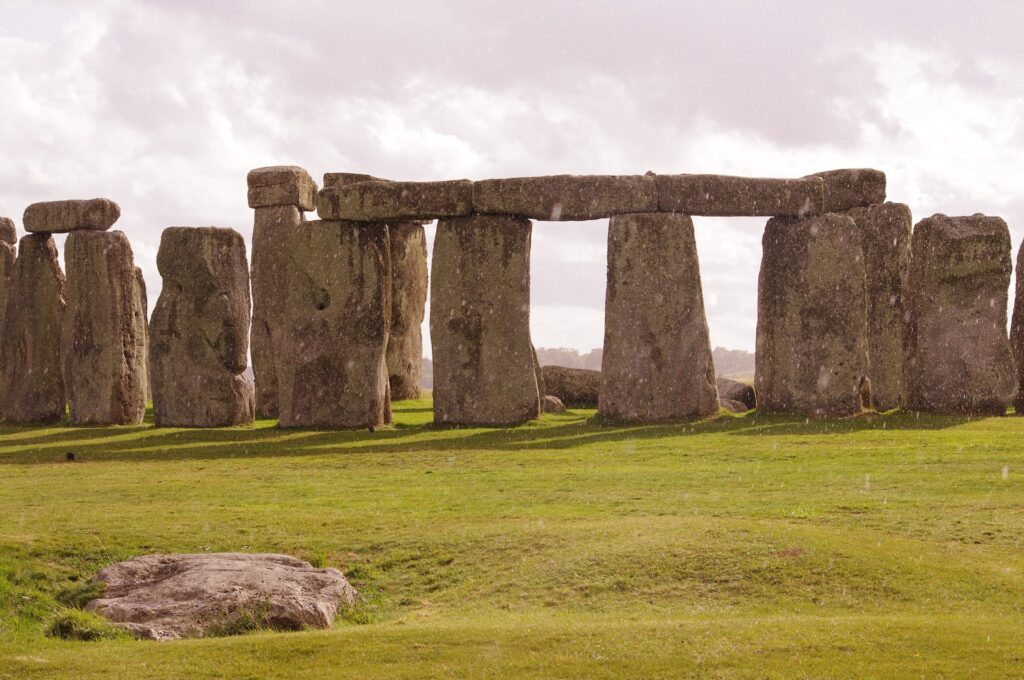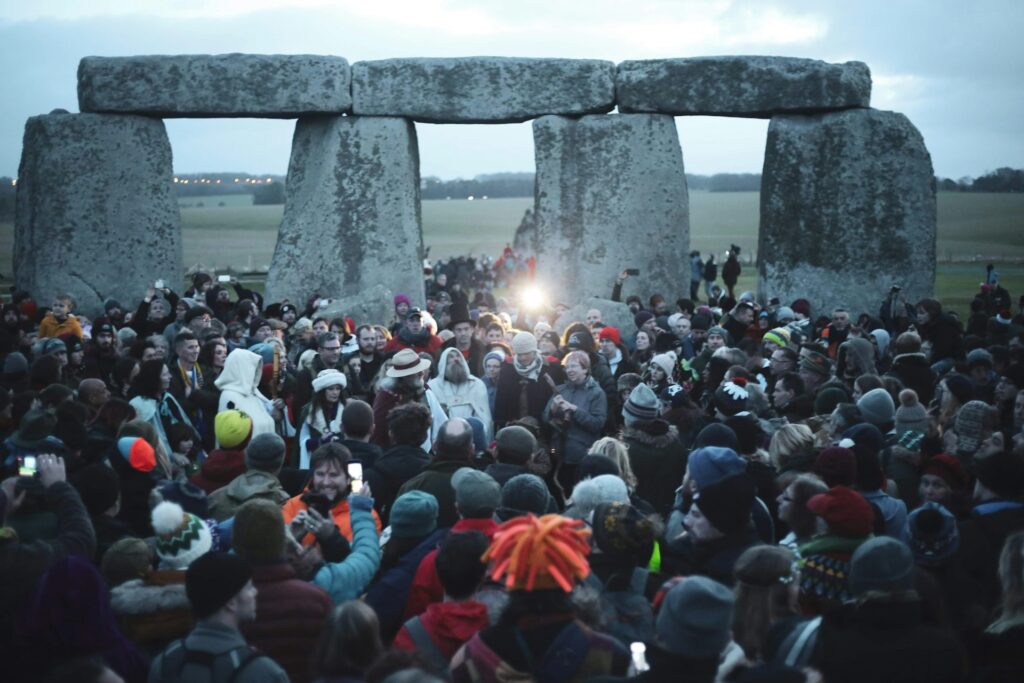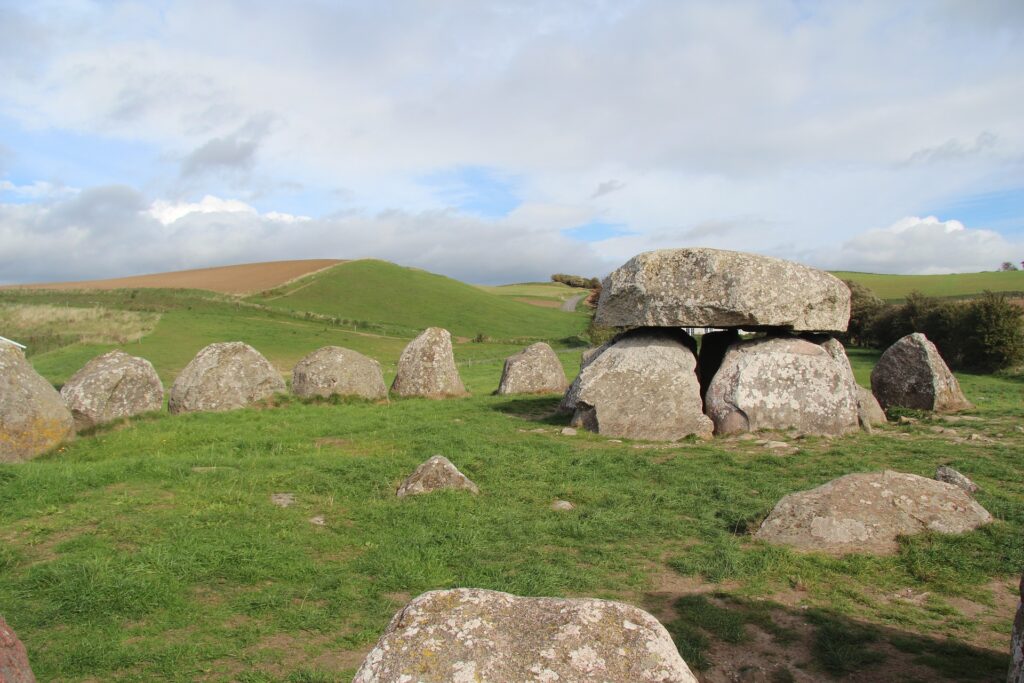Getting to Know Stonehenge
Introduction
Stonehenge stands as one of the most mysterious ancient structures on Earth. Situated in the Salisbury Plain in southwest England, this monumental stone monument has sparked the imagination and curiosity of people for millennia. Beyond the technological limits of its construction time, how the colossal stone blocks were transported and erected at Stonehenge remains unresolved. Additionally, numerous speculations exist regarding this monument’s purpose and use. The mystery of Stonehenge continues to captivate archaeologists, historians, and visitors alike, suggesting that it will continue to intrigue for centuries to come.
History of Stonehenge
Primary Monument
The first monument at Stonehenge, built in 3000 BC, is a circular earthwork. A ditch was dug using simple horn tools, and chalk was piled up to form an inner and an outer barrier. Inside the ditch was a ring of fifty-six wooden or stone posts. The monument served as a cremation cemetery for centuries.
About 2500 BC, the location was altered by building colossal stone structures. Large sarsen stones and smaller bluestones were raised to create a distinctive monument. Smaller stones from the Preseli Hills in southwest Wales are called bluestones. They weigh two to five tonnes and turn bluish when wet or fractured. A stone circle on the banks of the RiRiveralled West Amesbury Henge originally contained some of the bluestones.

Moving The Stones
Stonehenge has two different types of stones: the larger sarsen stones and the smaller bluestones. It was previously thought that sarsen stones, a silcrete found in southern England, came from the Marlborough Downs. However, new studies using an innovative geochemical method have confirmed the source of these stones and found that the West Woods area is more likely to be the source. The largest stone, the Heel Stone, weighs around thirty tons, while a typical sarsen weighs twenty-five tons.
Elevating The Stones
A wooden A-frame, ropes, and weights were used to draw the stone upright and then topple it after a sloping ditch had been dug and wooden pegs positioned behind it. The pit was then filled with debris.
Excavations and Research
Stonehenge, a Roman monument, was first excavated in the 1620s by the Duke of Buckingham, commissioned by King James I to survey the area. Inigo Jones, an antiquarian, argued that the Romans had built the monument.
Aubrey examined Stonehenge in the late 17th century and recorded the Aubrey Holes, which he later named after himself. Aubrey concluded that Romans or Danes did not build the stone circles; indigenous people built them. He attributed Stonehenge to the Druids, as they are the only prehistoric British priests mentioned in classical texts.
Early Period Excavations and Research
Sir William Flinders Petrie surveyed Stonehenge in 1874 and 1877 and developed a numbering system for the stones. Concerns about the stability of the rocks led to the flattening of a curved trilithon in 1901. Professor William Gowland directed excavations around the base, which he suggested was of late Neolithic or early Bronze Age date. Between 1919 and 1926, restoration and excavation work was carried out under the direction of Lieutenant-Colonel William Hawley, and much of the southeastern half of the monument was excavated.
Between 1950 and 1964, Richard Atkinson, Stuart Piggott, and JFS Stone began a new excavation at Stonehenge to address unanswered questions and respond to stabilization and reconstruction.

Restoration and Research
Atkinson proposed a three-stage chronology for Stonehenge, published in 1995. Excavations between 1966 and 2007 led to the discovery of Mesolithic pits in the car park, the ‘Stonehenge Archer’ burial in 1978, and a new stone hole, possibly a partner to the Heel Stone. The Royal Commission on Historic Monuments carried out survey work and completed the Stonehenge Environs Project.
Ten Years Of Excavation Work
Starting in 2002, there has been a renewed interest in exploring the landscape around Stonehenge, particularly its eastern side. Excavations have led to the discovery of Amesbury Archer, the oldest Bronze Age burial in Britain, along with other significant burials and a late Neolithic pit or post circle. The Stonehenge Riverside Project, led by Professor Mike Parker Pearson, aimed to test the hypothesis that Stonehenge was connected to a ceremonial timber and earth complex at Durrington Walls via the River Avon. Within the project’s scope, several tiny houses and structures made of wood and chalk were found, along with a road connecting the South Circle at Durrington Walls to the riRiverAnalysis of animal bones and pottery found at this settlement provided new insights into the feasting, rituals, and activities of the people who built and used Stonehenge.
In 2008, excavations at Stonehenge uncovered cremation burials dating from 3000 to 2800 BCE, representing over 50 individuals of various ages and genders. The analysis of the bones revealed that none of them had lived in the local area during the last decade of their lives, suggesting that people may have brought their cremated dead to Stonehenge from a distance.
Recent Research
Exciting discoveries have been made in the last several years. During excavations conducted in 2017 before the construction of new army accommodation, a new causewayed enclosure—an early Neolithic monument made up of circuits of segmental ditches—was discovered at Larkhill, north of Stonehenge.
Then, in 2020, the Stonehenge Hidden Landscapes Project declared that a vast network of shafts, which may be man-made pits or naturally occurring sinkholes, had been found encircling the Henge monument at Durrington Walls.[26] Later in the year, West Woods, 15 miles (25 km) north of the Marlborough Downs, was identified as the likely origin of the enormous sarsen stones by experts employing a cutting-edge geochemical method to analyze a core taken from Stonehenge.
Like Stonehenge, a new bluestone monument arc was found at Waun Mawn in the Preseli Hills. The size, shape, and possible alignment of the monument’s ‘gun sight’ entrance suggest that at least six bluestones were removed from the site. Based on the blank stone holes, at least three of the known unstained dolerites at Stonehenge may have been moved from this location. Furthermore, Early Bronze Age individuals buried at Stonehenge and those buried at Porton Down, Wilsford, and Amesbury Down cemeteries have been shown by researchers to have close genetic links, suggesting that these groups are related and of continental European origin.

Why Does The Stonehenge Matter?
The World Heritage Site of Stonehenge, Avebury, and Associated Sites contains an outstanding collection of ancient monuments of world significance. Of the prehistoric stone circles, Avebury is the largest in the world, and Stonehenge is the most structurally advanced. These and their associated monuments and surrounding landscapes help us understand Neolithic and Bronze Age funerary and ritual traditions. They show that the monuments were used and built continuously for almost 2000 years, from about 3700 to 1600 BC. They, therefore, represent a singular manifestation of a shared history.
A Distinctive Landscape
Stonehenge is part of a unique historic environment that includes early Neolithic, late Neolithic, and early Bronze Age structures. It does not stand alone. This landscape, which includes over 350 burial mounds and important prehistoric structures such as the Cursus, Stonehenge Avenue, Woodhenge, and Durrington Walls, provides a wealth of information about the ceremonial and burial customs of Neolithic and Bronze Age populations. It can also clarify the structure of ancient civilization and help us understand the regional and global exchanges between the fourth and second millennium BC.
As new evidence from excavations and state-of-the-art archaeological techniques continues to emerge, our knowledge of the monument constantly evolves.
More ideas have been put forward about the origin and function of Stonehenge than any other prehistoric structure. The most widely accepted explanation is that it was an ancient temple orientated according to the sun’s rays. It is the most notable example of the ceremonial complexes emerging in Britain and Ireland. They served as monuments to ancestors and calendar markers for important events. The sun was the center of this religious system, and the memorial structure incorporated solstice alignments.
And lastly, Stonehenge is a tremendous representation of ancient achievements and an emblem of the past. It has appeared in novels, music, and movies and served as the theme for several artworks and writings.
Even though Stonehenge’s history is still changing, it is more than just a chronicle of the past; it is a living, breathing source of inspiration for communities and tourists alike.
Movies and Books About Stonehenge
Books About Stonehenge
Stonehenge: A New Interpretation of Prehistoric Man and the Cosmos” – John North
Stonehenge Complete” – Christopher Chippindale
Stonehenge: Exploring the Greatest Stone Age Mystery” – Mike Parker Pearson
Stonehenge: The Story of a Sacred Landscape” – Francis Pryor
Stonehenge: A History of the Monuments and Its People” – Aubrey Burl
The Stonehenge People: An Exploration of Life in Neolithic Britain 4700-2000 BC” – Aubrey Burl
Stonehenge: Making Sense of a Prehistoric Mystery” – Julian Richards
Stonehenge: Neolithic Man and the Cosmos” – Gordon Freeman
Stonehenge: The Secret of the Solstice” – Terence Meaden
Stonehenge: A History in Photographs” – Julian Richards and David Straker
Movies About Stonehenge
“Stonehenge Apocalypse” (2010) – Paul Ziller
“Stonehenge: Decoded” (2008) – Clive Maltby
“National Geographic: Stonehenge Decoded” (2008) – John Michie
“Secrets of Stonehenge” (2010) – Russell England
“Stonehenge: The Lost Circle Revealed” (2009) – Nick Murphy
“Time Team: The Mystery of Stonehenge” (2003) – Tim Taylor
“Stonehenge: A New Understanding” (2013) – Graham Johnston
“Stonehenge: Britain’s Buried Treasure” (2013) – Rupert Smith
“In Search of History: The Lost Secrets of Stonehenge” (1999) – David M. Frank
“Mystery Files: Stonehenge” (2012) – Elizabeth Dobson.
Frequently Asked Questions About Stonehenge
What’s the Best Way to See Stonehenge?
Opting for a guided tour can provide valuable insights and information about Stonehenge’s history, significance, and surrounding area. Many tour operators offer guided tours that include transportation to and from Stonehenge and knowledgeable guides who can enhance your experience with their expertise.
How much time do you need in Stonehenge?
Can You Walk into Stonehenge?
No, you cannot walk up to the stone circle of Stonehenge without either a ticket or special access. English Heritage manages the site, and access to the monument is restricted to ensure its preservation and to control visitor numbers.
How near can I get to Stonehenge?
You will not be able to go up close to the stones. However, the atmosphere is tremendous whether you’re standing in the inner circle or watching from a distance. You will be able to enjoy the enchanting atmosphere that surrounds the fantastic masonry.
How Much Does It Cost to Visit?
For adults, it costs about 28-30 Euros
For children, it costs about 17-18 Euros
What to wear on a Stonehenge visit?
There is always a strong wind up on the Plain, so dress in layers if you intend to come during the cooler months. If you visit during the summer, wear proper walking shoes and clothing for the temperature.
Can Tourists Touch Stonehenge?
No person may touch, lean against, stand on, climb, or disturb the stones or the ground. No equipment can be attached to, leaned on, or supported by the rocks.
Can You Visit Stonehenge at Night?
Are There Toilets at Stonehenge?
Male and female toilets, including accessible baby and adult change facilities, are available at the visitor center.
Visiting Stonehenge with a dog.
Unfortunately, dogs cannot be transported to Stonehenge or on the shuttle buses. The fields surrounding it are also limited to prevent dogs from harming sheep. However, assistance dogs are authorized throughout the premises.










